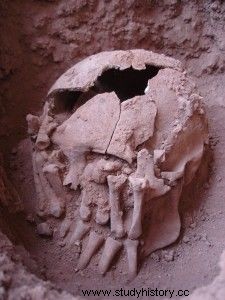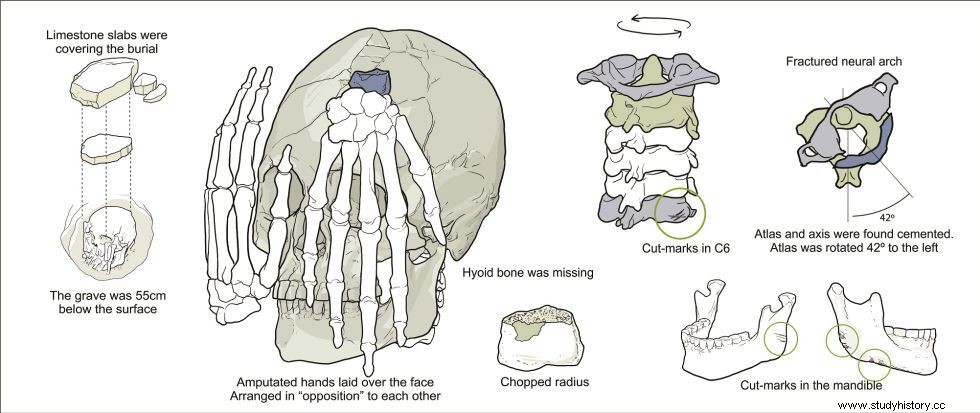The researcher of this project , André Strauss, from the Department of Evolutionary Anthropology at the Max Planck Institute, together with the collaboration by Domingo Salazar-García, a biomolecular archaeologist from the Department of Prehistory at the University of Valencia, have published the results of the study in a recent article in the journal PLoS One. , and especially those related to a specific burial:tomb 26 . The mentioned tomb consists of a male individual, a man decapitated and whose hands were amputated and placed on his face. Inside the grave, the skull, hands and six vertebrae were found, but without the presence of trousseau . Each of the hands is in a different position , the right one is placed over the left eye pointing towards the bottom of the pit and the left one over the right eye pointing towards the roof of the pit. The circular burial , about 40 cm in diameter, was covered with five slabs limestone.


In the societies of American prehistory the evidence of decapitation are very common, as well as those of cutting hair of the enemy, in order to later palisade those anatomical parts in the squares or entrances of the cities as a warning and status . The interesting thing about this new case is that it is the oldest beheading documented in America, as revealed by the dating test carried out on collagen content in the bones of the individual, and which has offered a date of around 9000 years BP (7000 BC). According to the post-processual interpretation According to the researchers, this tomb could serve as a means of group cohesion, using the execution as a form of participation by society as a whole.
At first it was thought that it could be an enemy by the type of treatment towards the deceased, but Salazar-García analyzed the isotope levels of the enamel and strontium content in the dental pieces and concluded that it is a member of the own community since, according to the results, it belonged to the same geographical area and with the same diet as the rest of the individuals found in Lapa do Santo.
Undoubtedly, the most relevant contribution of this research is that, according to taphonomic studies applied to the individual, it can be seen that anatomical knowledge of those who carried out the amputation of the hands and the decapitation was much higher than what was thought until now by communities of chronologies so far from the present. This interpretation is guaranteed by the fact that the cut marks that can be seen in the bone reveal that the cuts were made with small flakes (between 2 and 4 centimeters) and they only made two types cutting:in the jaw to strip tendons or muscles, and another in the vertebrae to definitively separate the head. The number of cut marks found on the skeleton isminimal , which allows us to assume that the skill and knowledge anatomical were wide . These types of finds are more common in the Andean area, but the location of this deposit of Lapa do Santo is quite far geographically and chronologically from what has been found to date.
Much remains to be learned about the «new continent» which, according to mounting evidence, does not deserve such an appellation.
